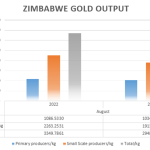
OPINION: Governments will be key to more resilient infrastructure in the future
By Almot Maqolo
HARARE – The South African Development Community (SADC) is in a crucial phase as it deals with infrastructure development to improve interconnectivity, competitiveness, and intra-African commerce. The SADC is also dealing with severe socioeconomic and environmental concerns. Governments in Southern Africa continue to bear the crushing weight of unprecedently high growth in the region’s youth population, the astounding rate of urbanization, and the expansion of informal settlements in metropolitan areas.
Unprecedented solutions are needed to build the necessary physical infrastructure to handle the current problems. To promote equitable and inclusive policies that encourage human flourishing, it is necessary to take other measures, such as stronger cooperation between SADC Member States, the corporate sector, and civil society. Governments must prioritize numerous transformative initiatives that produce and implement stimulus packages that rely on enabling infrastructure in order to build a more resilient infrastructure in the future. The term “regional infrastructure connectivity” refers to the physical, policy, and administrative linkages that exist between the regional economies through the use of facilities and structures that permit the free flow of people, products, services, and ideas throughout the region.
The goal is to strengthen SADC Member States’ capacities to be more resilient and better prepared for future global shocks by putting more emphasis on regional interconnection and collaboration. Delivery of regional infrastructure is frequently made much more difficult by the lack of efficient coordination structures, regulatory harmonization, and financial approaches that are difficult to implement simultaneously in numerous jurisdictions. For a thorough understanding of individual infrastructure gaps and requirements, SADC organizations and institutions need current, in-depth economic data.
If the contextually appropriate options are taken into consideration and decisions are made to better use the future for decisive policy today, SADC may be poised for a transformation in its infrastructure development trajectory toward better planning, proper policy implementation, and cleaner, greener infrastructure options. However, in Zimbabwe, there is still much to be done in terms of the infrastructure that supports the industry.
The majority of investment has been focused on increasing production at the mine and plant level. Due to economic difficulties, infrastructure development and improvement in Zimbabwe have been sluggish. The government has designated it as a priority issue because of the “knock-on effects” it has on the health of the economy as a whole. The primary means of transportation in the nation is the road system. Additionally, Zimbabwe connects
Southern Africa with a few regional highways. Major restoration and resurfacing efforts are now being made on the nation’s road network. The Ministry of Transport and Infrastructural Development received ZWL60.8bn from the 2022 National Budget. Zimbabwe previously relied on rail transportation for the movement of bulk goods within the country as well as to the seaports of Beira and Maputo in Mozambique; Dar es Salam in Tanzania, as well as to South Africa and Botswana. This was due to the wide variety of minerals that are mined in Zimbabwe.
Road travel is far more expensive than rail transit. All mining sites are connected to the national rail network. However, the state of the railway system is a cause for worry. The government allocated ZWL $2 billion in the 2022 National Budget for renovating several crucial sections on the Hwange-Harare railway line. The trend toward country protectionism and leadership self-interest that COVID-19 has fostered throughout Africa must clearly be reversed. SADC can improve its preparation for upcoming global shocks by putting more emphasis on increased regional interconnection and regional cooperation.


